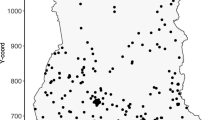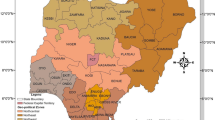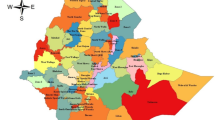Abstract
Globally, the risk of a child dying before celebrating their fifth birthday is still high at 5.3 million deaths in 2018 alone. Nigeria is among the few countries that are yet to achieve the Sustainable Development Goal Target of keeping under-5 death to as low as 25 deaths per 1000 live births by 2030. A recent study found that the under-5 mortality rate in Nigeria is still high with 1 in 8 Nigerian children dying before reaching the age of 5. In this study, the effect of a child’s spatial location in Nigeria on their likelihood of dying before age 5 was examined alongside other key covariates. Bayesian geo-additive regression models were fitted to the 2018 Nigeria Demographic and Health Surveys data. Statistical inference was based on the Bayesian paradigm via Markov chain Monte Carlo simulation methods, and models were assessed using the deviance information criterion. Under-five mortality rate varied significantly across spatial locations in Nigeria with Kebbi, Jigawa, Kaduna, Kogi and Gombe states having the highest rates. The likelihood of a child dying before age 5 increased among women with primary education and women aged 38 years and over. Other characteristics associated with high under-5 death are poverty, male child, low birth weight and multiple births. The current study has helped to identify geographical ‘hotspots’ as well as the key factors driving under-5 deaths in Nigeria to inform the effective design and implementation of timely and efficient interventions.




Similar content being viewed by others
Abbreviations
- CI:
-
Confidence interval
- CrI:
-
Credible interval
- FCT:
-
Federal capital territory
- GRF:
-
Gaussian random field
- NDHS:
-
Nigeria demographic and health survey
- DIC:
-
Deviance information criterion
- INMR:
-
Infant mortality rate
- IWLS:
-
Iteratively weighted least square
- LMIC:
-
Low- and middle-income countries
- MCMC:
-
Markov chain Monte Carlo
- MRF:
-
Markov random field
- NPC:
-
National population commission
- OR:
-
Odds ratio
- POR:
-
Posterior odds ratio
- SDG:
-
Sustainable development goal
- UHC:
-
Universal health coverage
- U5MR:
-
Under-five mortality rate
References
Abir, T., Agho, K. E., & Page, A. N. (2015). Risk factors for under-5 mortality: Evidence from Bangladesh demographic and health survey, 2004–2011. British Medical Journal Open, 5(1), e006722. https://doi.org/10.1136/bmjopen-2014-006722.
Acácio, S., Mandomando, I., Nhampossa, T., Quintó, L., Vubil, D., Sacoor, C., et al. (2019). Risk factors for death among children 0–59 months of age with moderate-to-severe diarrhea in Manhiça district, southern Mozambique. BMC Infectious Diseases, 19(1), 1–14. https://doi.org/10.1186/s12879-019-3948-9.
Adebowale, A. S., Fagbamigbe, A. F., Morakinyo, O., Obembe, T., Afolabi, R. F., & Palamuleni, M. E. (2020). Parental educational homogamy and under-five mortality in Sub-Saharan Africa: Clarifying the association’s intricacy. Scientific African, 7(2020), e00255. https://doi.org/10.1016/j.sciaf.2019.e00255.
Adedini, S. A., Odimegwu, C., Imasiku, E. N. S., & Ononokpono, D. N. (2015). Ethnic differentials in under-five mortality in Nigeria. Ethnicity and Health, 20(2), 145–162. https://doi.org/10.1080/13557858.2014.890599.
Adeyele, I. T., & Ofoegbu, D. I. (2015). Infant and child mortality in Nigeria : An impact. Analysis, 3(2), 122–132.
Adhikari, R., & Sawangdee, Y. (2011). Influence of women’s autonomy on infant mortality in Nepal. Reproductive Health, 8(1), 7. https://doi.org/10.1186/1742-4755-8-7.
Akinyemi, J. O., Adebowale, A. S., Bamgboye, E. A., & Ayeni, O. (2015a). Child survival dynamics in Nigeria: Is the 2006 child health policy target met? Nigerian Journal of Health Sciences, 15(1), 18. https://doi.org/10.4103/1596-4078.171378.
Akinyemi, J. O., Bamgboye, E. A., & Ayeni, O. (2015b). Trends in neonatal mortality in Nigeria and effects of bio-demographic and maternal characteristics. BMC Pediatrics, 15, 36. https://doi.org/10.1186/s12887-015-0349-0.
Alkema, L., Chao, F., You, D., Pedersen, J., & Sawyer, C. C. (2014). National, regional, and global sex ratios of infant, child, and under-5 mortality and identification of countries with outlying ratios: A systematic assessment. The Lancet Global Health, 2(9), e521–e530. https://doi.org/10.1016/S2214-109X(14)70280-3.
American Society for Reproductive Medicine. (2012). Multiple pregnancy and birth : Twins , triplets , and high-order multiples. Washington, DC. Retrieved from https://www.reproductivefacts.org/news-and-publications/patient-fact-sheets-and-booklets/documents/fact-sheets-and-info-booklets/multiple-pregnancy-and-birth-twins-triplets-and-high-order-multiples-booklet/.
Ayele, D. G., Zewotir, T. T., & Mwambi, H. G. (2015). Structured additive regression models with spatial correlation to estimate under-five mortality risk factors in Ethiopia Biostatistics and methods. BMC Public Health, 15(1), 1–11. https://doi.org/10.1186/s12889-015-1602-z.
Bado, A. R., Susuman, A. S., & Nebie, E. I. (2016). Trends and risk factors for childhood diarrhea in sub-Saharan countries (1990–2013): assessing the neighborhood inequalities. Global Health Action, 9, 30166. https://doi.org/10.3402/gha.v9.30166.
Belitz, C., Brezger, A., Klein, N., Kneib, T., Lang, S., & Umlauf, N. (2015). BayesX - Bayesian inference in structured additive regression models: Version 3.0.2 Retrieved from https://www.uni-goettingen.de/de/bayesx/550513.html.
Besag, J. E., York, J. C., & Mollié, A. (1991). Bayesian image restoration, with two applications in spatial statistics (with discussion). Annals of the Institute of Statistical Mathematics, 43, 1–59.
Brezger, A. L. (2006). Generalized structured additive regression based on Bayesian P-spline. Computational Statistics and Data Analysis, 50, 947–991.
Chao, F., You, D., Pedersen, J., Hug, L., & Alkema, L. (2018). National and regional under-5 mortality rate by economic status for low-income and middle-income countries: a systematic assessment. The Lancet Global Health, 6(5), e535–e547. https://doi.org/10.1016/S2214-109X(18)30059-7.
Costa, J. C., Da Silva, I. C. M., & Victora, C. G. (2017). Gender bias in under-five mortality in low/middle-income countries. BMJ Global Health. https://doi.org/10.1136/bmjgh-2017-000350.
Dejene, T., & Girma, E. (2013). Social determinants of under-five mortality in Ethiopia: Event history analysis using evidence from Ethiopian Demographic and Health Survey (EDHS). Health, 05(05), 879–884. https://doi.org/10.4236/health.2013.55115.
Doku, D. T., Bhutta, Z. A., & Neupane, S. (2020). Associations of women ’ s empowerment with neonatal, infant and under-5 income mortality in low- and/middle-countries: Metaanalysis of individual participant data from 59 countries. BMJ Global Health, 5(e001558), 1–11. https://doi.org/10.1136/bmjgh-2019-001558.
Eilers, P. H. C., & Marx, B. D. (1996). Flexible smoothing with b-splines and penalties. Statistical Science, 11, 89–121.
Ezeh, O. K., Agho, K. E., Dibley, M. J., Hall, J., & Page, A. N. (2014). Determinants of neonatal mortality in Nigeria: Evidence from the 2008 demographic and health survey. BMC Public Health, 14(1), 521. https://doi.org/10.1186/1471-2458-14-521.
Ezeh, O. K., Agho, K. E., Dibley, M. J., Hall, J. J., & Page, A. N. (2015). Risk factors for postneonatal, infant, child and under-5 mortality in Nigeria: A pooled cross-sectional analysis. British Medical Journal Open, 5(3), e006779. https://doi.org/10.1136/bmjopen-2014-006779.
Fagbamigbe, A. F., & Akinyemi, J. O. (2016). Modelling the survivorship of Nigeria children in their first 10 years of life. The Nigerian Health Journal, 16(1), 1–19.
Fagbamigbe, A. F., & Alabi, O. (2014). Differentials and correlates of infants mortality in Nigeria : A comparative survival analysis between North East and South West Nigeria. International Journal of Tropical Disease and Health, 4(8), 869–886.
Fagbamigbe, A. F., Bamgboye, E. A., Yusuf, B. O., Akinyemi, J. O., Issa, B. K., Ngige, E., et al. (2015). The Nigeria wealth distribution and health seeking behaviour: Evidence from the 2012 national HIV / AIDS and reproductive health survey. Health Economics Review, 5(5), e1–e10. https://doi.org/10.1186/s13561-015-0043-9.
Fagbamigbe, A. F., Kandala, N. B., & Uthman, O. A. (2020a). Decomposing the educational inequalities in the factors associated with severe acute malnutrition among under-five children in low- and middle-income countries. BMC Public Health, 20(555), 1–14. https://doi.org/10.1186/s12889-020-08635-3.
Fagbamigbe, A. F., Kandala, N. B., & Uthman, O. A. (2020b). Severe acute malnutrition among under-five children in low- and middle-income countries: A hierarchical analysis of associated risk factors. Nutrition, 75–76(2020), 110768. https://doi.org/10.1016/j.nut.2020.110768.
Faust, L., Yaya, S., & Ekholuenetale, M. (2017). Wealth inequality as a predictor of HIV-related knowledge in Nigeria. BMJ Global Health, 12, e000461. https://doi.org/10.1136/bmjgh-2017-000461.
Gelman, A., & Little, T. (1997). Postratification into many categories using hierarchical logistic regression. Survey Methodology, 23(2), 127–135.
Gilks, W. R., & Wild, P. (2006). Adaptive rejection sampling for Gibbs sampling. Journal of the Royal Statistical Society, Series C Applied Statistics, 41(2), 337–348. https://doi.org/10.2307/2347565.
Kalbfleisch, J. D., & Prentice, R. L. (2002). The statistical analysis of failure time data (2nd ed.). New York: Wiley.
Kandala, N. B., Nnanatu, C. C., & Atilola, G. (2019). A spatial analysis of the prevalence of female genital mutilation/cutting among 0–14-year-old girls in Kenya. International Journal of Environmental Research and Public Health, 16(21), 4155. https://doi.org/10.3390/ijerph16214155.
Kandala, N.-B., Nwakeze, N., & Ngianga, S. K. I. (2009). Spatial distribution of female genital mutilation in Nigeria. American Journal of Tropical Medicine and Hygiene, 81(5), 784–792.
Kayode, G. A., Adekanmbi, V. T., & Uthman, O. A. (2012). Risk factors and a predictive model for under-five mortality in Nigeria: Evidence from Nigeria demographic and health survey. BMC Pregnancy and Childbirth, 12(1), 10.
Klein, N., Kneib, T., Lang, S., & Sohn, A. (2015). Bayesian structured additive distributional regression with an application to regional income inequality in Germany. Annals of Applied Statistics, 9(2), 1024–1052.
Kneib, T., & Fahrmeir, L. (2006). Structured additive regression for multicategorical space-time data: A mixed model approach. Biometrics, 63, 109–118.
Little, R. J. A. (1993). Post-stratification: A modeler’s perspective. Journal of the American Statistical Association, 88(423), 1001. https://doi.org/10.2307/2290792.
Little, R. J. A. (2012). Calibrated Bayes, an alternative inferential paradigm for official statistics. Journal of Official Statistics, 28(3), 309–334.
Liu, L., Oza, S., Hogan, D., Perin, J., Rudan, I., Lawn, J., et al. (2015). Global, regional, and national causes of child mortality in 2000–2013, with projections to inform post-2015 priorities: An updated systematic analysis. The Lancet, 385(9966), 430–440. https://doi.org/10.1016/s0140-6736(16)31593-8.
Liu, L., Oza, S., Hogan, D., Perin, J., Rudan, I., Lawn, J., et al. (2016). Global, regional, and national causes of under-5 mortality in 2000–2015: An updated systematic analysis with implications for the sustainable development goals. The Lancet, 388(10063), 3027–3035. https://doi.org/10.1016/s0140-6736(16)31593-8.
Malec, D., Davis, W. W., & Cao, X. (1999). Model-based small area estimates of overweight prevalence using sample selection adjustment. In Statistics in medicine (Vol. 18, pp. 3189–3200). Wiley. https://doi.org/https://doi.org/10.1002/(SICI)1097-0258(19991215)18:23<3189::AID-SIM309>3.0.CO;2-C
Molina, I., Nandram, B., & Rao, J. N. K. (2014). Small area estimation of general parameters with application to poverty indicators: A hierarchical Bayes approach. Annals of Applied Statistics, 8(2), 852–885. https://doi.org/10.1214/13-AOAS702.
Morakinyo, O. M., & Fagbamigbe, A. F. (2017). Neonatal, infant and under-five mortalities in Nigeria: An examination of trends and drivers (2003–2013). PLoS ONE, 12(8), e0182990. https://doi.org/10.1371/journal.pone.0182990.
Mosley, W. H., & Chen, L. C. (1984). An analytical framework for the study of child survival in developing countries. Population and Development Review, 10, 25. https://doi.org/10.2307/2807954.
Mukabutera, A., Thomson, D. R., Hedt-gauthier, B. L., Basinga, P., Nyirazinyoye, L., & Murray, M. (2016). Risk factors associated with underweight status in children under five: An analysis of the 2010 Rwanda Demographic Health Survey (RDHS). BMC Nutrition, 2(40), 1–12. https://doi.org/10.1186/s40795-016-0078-2.
National Population Commission (NPC) [Nigeria] & ICF International. (2009). Nigeria Demographic and Health Survey, 2008. DHS Measure Macro, New York and Nigeria Population Commission, Abuja, Nigeria.
National Population Commission (NPC) [Nigeria], & ICF International. (2014). Nigeria Demograhic Health Survey, 2013. Abuja.
National Population Commission (NPC) [Nigeria], & ICF International. (2019). Nigeria Demographic and Health Survey 2018. Abuja, Nigeria, And Rockville, Maryland, USA.
Rao, J. N. K., & Molina, I. (2015). Small area estimation (2nd edn., Vol. 1). Hoboken, New Jersey: Wiley. Retrieved from https://www.wiley.com/en-gb/Small+Area+Estimation%2C+2nd+Edition-p-9781118735787.
Si, Y., Pillai, N. S., & Gelman, A. (2015). Bayesian nonparametric weighted sampling inference. Bayesian Analysis, 10(3), 605–625. https://doi.org/10.1214/14-BA924.
Spiegelhalter, D., Best, N., Carlin, B., & Van der Line, A. (2002). Bayesian measures of models complexity and fit. Journal of the Royal Statistical Society: Series B, 64, 1–34.
Sugasawa, S. (2020). Small area estimation of general parameters: Bayesian transformed spatial prediction approach. Japanese Journal of Statistics and Data Science, 3(1), 167–181. https://doi.org/10.1007/s42081-019-00067-7.
Tobler, W. (1970). A computer movie simulating urban growth in the Detroit region. Economic Geography, 46(Suppl), 234–240.
Umlauf, N., Adler, D., Kneib, T., Lang, S., & Zeileis, A. (2015). Structured additive regression models: An R interface to BayesX. Journal of Statistical Software, 63211–46. Retrieved from http://www.jstatsoft.org/v63/i21/.
UN Inter-agency Group for Child Mortality. (2019). Level and trends in child mortality. New York.
UNICEF. (2020). Child-survival: Under-five mortality. Retrieved from April 23, 2020. https://data.unicef.org/topic/child-survival/under-five-mortality/.
United Nations. (2015). Sustainable development goals (SDG). Washington, DC. Retrieved from. http://www.un.org/sustainabledevelopment/sustainable-development-goals/.
United Nations Population. (2020). United Nations World Population Prospects 2019. Retrieved from May 9, 2020. https://population.un.org/wpp/Download/Standard/Population/.
WHO. (2020). Under-five mortality. Retrieved from May 9, 2020. https://www.who.int/gho/child_health/mortality/mortality_under_five_text/en/.
Yaya, S., Bishwajit, G., Okonofua, F., & Uthman, O. A. (2018). Under five mortality patterns and associated maternal risk factors in sub-Saharan Africa: A multi-country analysis. PLoS ONE. https://doi.org/10.1371/journal.pone.0205977.
Yaya, S., Ekholuenetale, M., Tudeme, G., Vaibhav, S., Bishwajit, G., & Kadio, B. (2017). Prevalence and determinants of childhood mortality in Nigeria. BMC Public Health, 17(1), 485. https://doi.org/10.1186/s12889-017-4420-7.
Yaya, S., Uthman, O. A., Okonofua, F., & Bishwajit, G. (2019). Decomposing the rural-urban gap in the factors of under-five mortality in sub-Saharan Africa? Evidence from 35 countries. BMC Public Health, 19(1), 1–10. https://doi.org/10.1186/s12889-019-6940-9.
You, D., New, J., & Wardlaw, T. (2010). Levels and trends in child mortality. Report 2012. Estimates developed by the UN inter-agency Group for Child Mortality Estimation.
Zhang, X., Holt, J. B., Lu, H., Wheaton, A. G., Ford, E. S., Greenlund, K. J., & Croft, J. B. (2014). Multilevel regression and poststratification for small-area estimation of population health outcomes: A case study of chronic obstructive pulmonary disease prevalence using the behavioral risk factor surveillance system. American Journal of Epidemiology, 179(8), 1025–1033. https://doi.org/10.1093/aje/kwu018.
Author information
Authors and Affiliations
Corresponding author
Ethics declarations
Conflict of interest
The authors declare no conflict of interest.
Additional information
Publisher's Note
Springer Nature remains neutral with regard to jurisdictional claims in published maps and institutional affiliations.
Appendix
Appendix
In the Bayesian paradigm, the unknown functions \({\text{f}}_{j}\) and parameters \({\upgamma }\) and the variance \(\sigma^{2}\) or the precision \(\tau^{2} = 1/\sigma^{2}\) are treated as latent and random variables which are to be estimated. In general, Bayesian inference is performed by evaluating the posterior distribution \(\pi (\theta |{\varvec{y}},{\varvec{x}})\), which may be approximate as the product of the joint likelihood function, \(L\left( {\theta ;{\varvec{y}},{\varvec{x}}} \right)\) and the joint prior distributions \(\pi \left( {\varvec{\theta}} \right)\), where \({\varvec{\theta}}\) is a vector of the unknown parameters.
Furthermore, for our purpose, we assign independent diffuse priors to the parameters \(\gamma_{j} \propto \,{\text{const}},\, j = 1, \ldots ,r\) of the \(r\) fixed effects covariates, \(z_{i} = \left( {z_{i1} , z_{i2} , \ldots ,z_{ir} } \right)\). Although, highly dispersed Gaussian priors could still be used. Following Kandala et al. (2019).and to reflect spatial neighbourhood structure, we assigned Markov random fields (MRF) priors to the correlated spatial effect \(f_{str} \left( s \right), s = 1, \ldots , S\), (Besag et al. 1991). Note that the MRF prior is the spatial extension of random walk models and is defined by Eq. 7
where \(N_{s}\) is the number of adjoining states to state \(s\), and \(r\delta_{s}\) denotes that region \(r\) is a neighbour of region \(s\). Hence the (conditional) mean of \(f_{str} \left( s \right)\) is the average of functions \(f_{str} \left( s \right)\) of the neighbouring regions, where \(\tau_{str}^{2}\) is a smooth parameter. On the other hand, we assign zero-mean independent and identically distributed Gaussian priors to the uncorrelated (unstructured) spatial effect \(f_{unstr} \left( s \right)\) as equation
As before, we assign inverse gamma-distributed priors to the smooth parameters such that \(p\left( {\tau_{j}^{2} } \right)\sim IG\left( {a_{j} ,b_{j} } \right),\) where \(j\) here is a generic subscript representing both \(str\) and \(unstr\) and where \(a\) and \(b\) are hyperparameters. Usually, the hyperparameters are chosen to be vague and in our case, we chose \(a = b = 0.001.\)
Furthermore, to estimate the smooth functions, \(f_{1} , \ldots , f_{p}\), we used cubic splines which are twice continuously differentiable piecewise cubic polynomials. However, the spline can be written as a linear combination of B-spline basis functions \(B_{m} \left( x \right)\), the Bayesian version of the Penalized–Splines (P-Splines) proposed by Eilers and Marx (1996), such that \(f\left( x \right) = \mathop \sum \nolimits_{m = 1}^{l} \beta_{m} B_{m} \left( x \right)\). In our approach, this corresponds to 2nd order random walks given by Eq. 9
with Gaussian increments \(\mu_{m} \sim N\left( {0,\tau^{2} } \right)\) which is estimated from data and where the smoothness parameter \(\tau\) is also estimated from the data.
For Bayesian inference, samples \({\varvec{\theta}} = \left( {\left\{ {\varvec{f}} \right\},{\varvec{f}}_{{{\varvec{unstr}}}} ,{\varvec{f}}_{{{\varvec{str}}}} ,{\varvec{\tau}}_{{{\varvec{unstr}}}} ,{\varvec{\tau}}_{{{\varvec{str}}}} } \right)\) are drawn from the posterior distribution of the latent parameters \(\pi ({\varvec{\theta}}|{\varvec{x}},{\varvec{y}})\) using Markov chain Monte Carlo (MCMC) simulation (Gilks and Wild 2006). For our purpose, we used iteratively weighted least square (IWLS) proposal (Klein et al. 2015; Kneib and Fahrmeir 2006).
The models were then fitted in R statistical programming software version 3.6.1 using R2BayesX (Umlauf et al. 2015), the R interface BayesX, a popular statistical software for fitting various classes of generalized additive mixed models (Belitz et al. 2011). For our study, 20,000 samples were simulated from the posterior distributions. Then, after a burn-in period of 4000 iterations which was discarded on the assumption that the 4000 initial chains may not have converged at the stationary distribution, we summarized the posterior after selecting only every 10th of the remaining 16,000 samples. This is also called thinning. Both the burn-in and thinning are used to ensure that the posterior samples are approximately independent.
Using sensitivity analysis, we investigated the appropriateness of the MRF priors by fitting the spatial model using Gaussian Random Field (GRF) priors. However, we found no evidence of a better fit with the GRF. Besides, the sparseness introduced by the neighbourhood structure of the MRF of a particular computational advantage and greatly reduces computational costs.
Rights and permissions
About this article
Cite this article
Fagbamigbe, A.F., Nnanatu, C.C. Modelling the Spatial Distribution and the Factors Associated with Under-Five Mortality in Nigeria. Spat Demogr 10, 255–282 (2022). https://doi.org/10.1007/s40980-021-00078-7
Accepted:
Published:
Issue Date:
DOI: https://doi.org/10.1007/s40980-021-00078-7




